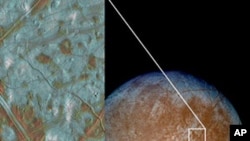The U.S. space agency says data from a planetary mission shows what appears to be a large body of water beneath Jupiter's ice-covered moon, Europa, which could harbor life.
NASA says the data is especially significant because it suggests the possibility of a vast saltwater ocean below Europa's icy shell that's deep enough to cover the entire globe. The findings are published in the journal Nature.
The lead author, Britney Schmidt of the University of Texas at Austin, said one opinion in the scientific community has been if the ice shell is thick, that is bad for biology, since the surface might not be interacting with the underlying ocean. However, she said now there is evidence that the relatively warm water below may be welling up in plumes that fracture the icy shell, meaning energy and nutrients could move between the oceans and the surface. She said there is new evidence, as well, for giant shallow lakes, which Schmidt said could make Europa and its ocean more hospitable to life.
NASA officials say the findings could "bolster arguments that Europa's global subsurface ocean represents a potential habitat for life elsewhere in our solar system."
The data is from the Galileo spacecraft, which was launched to Jupiter in 1989. The mission, which NASA says changed the way our solar system is viewed, ended in 2003.
Some information for this report was provided by AFP.












